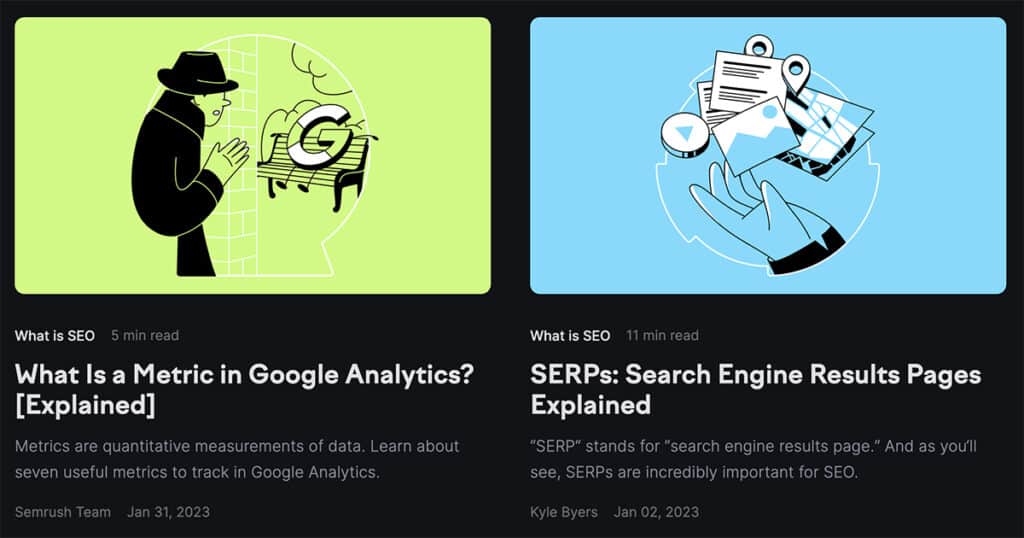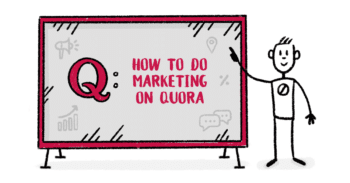SaaS Content Marketing: The Ultimate Guide to Growth

To succeed in the SaaS industry, you need more than a skilled sales team or excellent product-market fit. (Although both can certainly help.)
With approximately 30,000 active companies and end-user spending projected to exceed $195 billion, SaaS is poised to be one of the most competitive spaces in 2023 and beyond.
So how can your company stand out against the competition and leverage some of this massive growth potential—while keeping customer acquisition cost (CAC) in check?
SaaS content marketing is the key to reaching your target audience, building authority in your category, and acquiring more customers without advertising.
In this article, you’ll discover why content marketing gives B2B SaaS businesses a unique edge, get a framework for a successful strategy, and learn what kind of content to create for your SaaS now.
What is SaaS content marketing?
SaaS content marketing is a strategy for attracting, educating, converting, and retaining ideal customers. It’s a long-term approach that requires producing high-value content on a consistent, ongoing basis.
Well-executed content marketing can:
- Attract more organic search traffic and improve brand awareness
- Generate more qualified leads and fill sales pipelines
- Drive key SaaS metrics like new monthly recurring revenue (MRR)
- Establish products, brands, and founders as industry leaders
- Improve loyalty and increase customer lifetime value (LTV)
Why does content marketing matter for SaaS?
Content marketing is hardly unique to the web-based software industry. But it is particularly important to SaaS for a few key reasons.
Long-lasting effects
One of the biggest benefits of content marketing is that it centers on search engine optimization (SEO). SEO isn’t an overnight solution, but it can lead to positive, long-lasting effects.
With a strong keyword strategy and outstanding funnel alignment, you can dramatically improve your organization’s visibility in relevant search results.
That means potential customers can discover your SaaS and gain valuable insights when searching for products, solutions, competitors, and other related topics.
Compared to other marketing channels, content marketing is also more defensible, adding to its long-term viability. Although you’ll certainly encounter competition for organic keywords, you can defend rankings by improving the content and reworking the strategy.
Cost-effective nature
SaaS companies looking for quick wins often use search ads and paid social to reach target customers. These tactics can help you reach your objectives and key results (OKRs) faster, and they can complement content marketing nicely.
Yet ads are far from inexpensive, especially for SaaS. According to Wordstream, in 2023, you can expect to pay an average cost per click (CPC) of nearly $4 and an average cost per lead (CPL) of nearly $90.
SaaS advertising isn’t getting any cheaper either. From 2021 to 2022, the average CPL rose by more than a third, and the landscape became increasingly saturated.
Paid growth also tends to be volatile, especially for pay-per-click (PPC) ads. Competitors with deeper pockets can outbid you for search keywords you’ve owned for weeks or months—which can completely throw off your math.
It’s true that SaaS content marketing is far from free. But it offers more predictability and less variation in cost, which can be ideal for sustained growth.
Lifetime value
Successful SaaS marketing content can absolutely lead to initial sales. But for most SaaS businesses, new customer acquisition is only the first step.
Given the SaaS subscription model, metrics like customer retention and LTV tend to drive much more value over time.
With targeted content, SaaS marketers can also educate existing customers and help them get more value from their purchases. By developing content for advanced users, SaaS marketers can increase retention, improve loyalty, and maximize LTV.
How SaaS Companies Approach Content Marketing Differently
Content marketing works a little differently for SaaS businesses. Here’s what sets this industry apart.
Product-led content
Historically, a lot of SaaS content has been educational or sales-focused. Now, top SaaS marketers increasingly use a product-led content model, which balances the two angles.
In short, product-led content addresses customer problems while positioning the SaaS as a viable solution. It takes a natural approach to problem-solving rather than appearing aggressively salesy.
To do product-led content well, you need a deep understanding of what your customers’ problems are, why the issues exist, and what they can gain from resolving these concerns. You also need to know how your SaaS can help and why it’s the ideal solution.
As an example, Ahrefs creates product-led content that helps customers solve SEO problems. The article pictured below expertly answers the question What are backlinks?

Without making a sales pitch, the article positions Ahrefs as a clear solution. First, it highlights free tools available to everyone. Then it demonstrates how Ahrefs can provide advanced backlink-checking capabilities to help users excel in this area.
Zero-click content
Product-led content often provides in-depth technical solutions. But you can’t expect busy prospects to read every word—or in many cases, to click through to your website at all.
Instead, you need a way to succeed in a platform-native world. Amanda Natividad, VP Marketing for SparkToro, has outlined a technique for zero-click content.
The key is providing value where prospects are so they can consume it without leaving the platform. For example, transforming long-form blog posts into bite-size takeaways for emails, Twitter threads, or LinkedIn posts is an efficient way to create zero-click content.

As you can see, zero-click content often gives away the good stuff way before attempting to get a click or a conversion. So what’s in it for your SaaS? This kind of content can actually improve brand awareness, build trust, and help prospects remember you.
When you do zero-click content well, you can expect your audience to convert—eventually. But without clicks, how can you track performance metrics? Amanda explains:
“It’s tough to track ROI of zero-click content but you could say the same for all non-performance-based marketing disciplines. Content marketers and senior leadership should be looking holistically at the results of their content marketing. They should track engagement, impressions, and follower/subscriber growth. They can also look at key performance indicators like business utility of content. For instance, a case study functions as sales collateral. Or product-led content serves double duty as help-desk content.”
Data-enriched content
Cloud-based software naturally produces a lot of analytics. Why retain SaaS data for internal purposes when you could also use it to inform and enhance your content?
Data can enrich B2B SaaS marketing efforts in a couple of valuable ways.
First, data can shape the stories you tell while adding unique insights. For example, your first-party data might give you a new perspective on customer problems, use cases, or even industry growth.
In addition, sharing original data can help you build more backlinks naturally. For example, this AdEspresso article on Facebook Ads costs contains statistics and benchmarks that you can’t get elsewhere. It’s generated more than 3,100 free backlinks from 1,200 domains.
AI competition
Many SaaS niches are already packed with content. With the rise of AI tools like ChatGPT, producing content at scale is likely to become cheaper, which may lead to oversaturation and tougher competition for keywords.
So how can your organization stand out against the competition—including both AI-informed content and human-written content?
Using the best practices below to create high-quality product-led content is a good start. But you also need a strategy for creating original content that adds real value and new ideas.
Si Quan Ong, Marketing Manager at Ahrefs, suggests rethinking your approach so you can rank at the top in a crowded SaaS space:
“Content marketers should be thinking like journalists in the first place. Interview subject matter experts, crowdsource opinions, crunch data, have a strong opinion, share personal experience, and so on. AI content still can’t do any of these, so if you’re investing and creating this type of content, you’ll still stand out from everyone.”
4 Types of Content to Create for Organic SaaS Marketing
Long-form articles are just one option for content marketing for SaaS. Here are a few content formats to consider adding to your strategy.
1. Blog posts
For most SaaS businesses, a blog is the cornerstone of a strong content marketing strategy. When you publish long-form blog posts consistently, you can pursue crucial keywords for your niche, which can improve visibility and brand awareness.
With a blog, you can also build content hubs that boost authority, build trust, and help you stand out against the competition. A successful blog often includes formats like:
- Ultimate guides to [primary customer problem]
- Everything you need to know about [key SaaS benefit]
- Comparison pages that measure your SaaS against a top competitor
- How [new feature you just launched] works
Long-form articles are also ideal for repurposing or positioning media from other content marketing channels. For example, you can embed or repurpose any of the other content types below to drive more views and downloads.
2. Videos
Long-form video is ideal for showing rather than telling how your SaaS can deliver benefits. With long-form videos, you can drill down into customer problems and position your product as a smart solution, even if it’s highly technical or if it has a steep learning curve.
If you publish to YouTube, you can also capture more ranking opportunities. Although the YouTube homepage is algorithm-driven, the platform’s search engine can drive discovery—especially if you create keyword-optimized titles and descriptions.
Yet YouTube doesn’t have to be the only destination for your long-form videos. You can also embed them into relevant blog posts or repurpose them into long-form articles.

As an example, Moz produces Whiteboard Friday, a weekly series for advanced SEO experts. Viewers can subscribe to the Moz YouTube channel to watch the series.

They also have the option to go to the Moz blog to read the transcript, view the presentation, and play the video without clicking away from the website.
3. Podcasts
Podcasts give your marketing team yet another avenue for establishing authority. This content type is ideal for sharing thought leadership and guiding conversations around your SaaS niche.
With podcasts, you can also expand your reach by tapping into a wider audience. Whether you invite influencers, marketers, and founders to your podcast or you make guest appearances on other podcasts, you can introduce your SaaS to a new audience.
As an example, Metadata hosts Demand Gen U, a podcast that explores demand generation, conversion rate optimization, and B2B marketing topics.

The advertising automation platform also repurposes each episode. Metadata publishes the podcast on YouTube and shares the transcript in a blog post, giving prospects multiple opportunities to discover and engage.
4. Lead magnets
Most of your SaaS marketing content will probably be ungated—meaning it’s freely available on your website or other owned channels.
Ungated content tends to be most effective for attracting top-of-funnel (TOFU) prospects who are just getting to know your business and your SaaS.
Yet gated content is also an important part of any SaaS content marketing plan. Because gated content tends to work better for prospects with intent, it’s ideal for middle- (MOFU) and bottom-of-funnel (BOFU) prospects who are closer to converting.
You can use gated content to get more subscribers, generate more leads, and even qualify leads. Every time you offer a lead magnet, you can ask qualifying questions and automatically add the data to your customer relationship management (CRM) tool.
In some cases, gated content is exclusive to paid campaigns, as it provides a high-value incentive for leads. But you can also incorporate gated content into other content marketing channels by embedding specific calls-to-action (CTA).
Best Practices for Building a SaaS Content Marketing Strategy
Could your SaaS content marketing strategy use some work? Are you designing one from scratch? Get started with this framework.
Know your ICP
To create genuinely helpful product-led content, you have to know your ICP from every angle. Go beyond basics like industries, job titles, and company names to understand what makes your ICP tick.
Position your ideal customers’ needs, challenges, and goals at the center of every piece of content you create. Use these questions as a guide:
- What are your ideal customers’ top business goals?
- Why do they want or need to achieve those goals? What’s the real benefit?
- What’s holding them back from achieving those goals?
- How can your product solve their problems and help them reach those goals?
- What’s their biggest objection to buying your product?
- Which competitors’ tools are they considering?
Make a point of reviewing these or similar questions periodically. As customer needs evolve and the SaaS landscape matures, the best way to connect with your ICP may shift.
Assess the maturity of the space
In addition to knowing your customer, you also need to know your space and understand how mature it is.
Is your SaaS niche already well-established? There’s a good chance that prospective customers can define their problems and figure out how to research solutions. That gives you a strong foundation to build product-led content.
In an immature space or a completely new niche, users may be neither problem- nor solution-aware. There’s a good chance you’ll need to broaden your approach to educate potential customers about the problem before pitching a solution.
Competitive research can give you an additional data point to guide your approach, especially in a mature niche.
Have your long-established competitors already created top-ranking ultimate guides on every imaginable topic? Exploring other content formats—such as podcasts or video series—may help your SaaS stand out in a crowded space.
Identify relevant keywords to target
Should you publish content exclusively for search engines? Absolutely not. Creating content that favors keyword density over real solutions isn’t likely to provide value or build trust.
Yet you should produce genuinely helpful product-led content that your target audience can actually find. That means you need keyword research to assess search queries and product positioning.
Keyword research can also reveal how broad your topics should be. Do your keywords have a relatively low search volume? In addition to creating content that’s specific to your niche, you’ll likely need to broaden your approach to attract the search volume you want.
Align your content with your sales funnel
As you use keyword research to develop a SaaS content marketing plan, make sure you understand the intent behind every search query. Then map each keyword to a relevant stage of your SaaS funnel.
Using this approach, you can create product-led content that speaks to prospective customers’ awareness levels and guides them further along in their buyer’s journey. Here’s a quick breakdown:
- TOFU content should target brand awareness and customer education
- MOFU content should build trust and assist with the consideration
- BOFU content should focus on decision-making and conversions
- Loyalty-focused content should encourage retention and advocacy
For example, search queries like “how to organize customer data” fit at the top of the funnel, where prospects are beginning their journey to find a solution.
Search queries like “best CRM tool” or “HubSpot vs. Salesforce” align with the middle or bottom of the funnel, where prospects are actively considering solutions, comparing options, and showing intent to purchase.
Should you create an equal amount of content for each stage of the funnel? Not necessarily.
The majority of the SaaS marketing content you create—as much as half—should target the top of the funnel. That’s where search volumes are highest and give you the greatest opportunity to add prospects to your funnel.
The closer you get to the bottom of the funnel, the less content you should create for each stage. That’s where search volumes naturally decrease as queries become more specific and solution-focused.
Create content pillars to build authority
It’s easy to assume that publishing more content will attract more prospects to your funnel. But when it comes to quality vs. quantity, the former wins every time.
Rather than churning out content for every possible keyword, focus on building content pillars strategically. Also known as content hubs, they’re essential for creating and organizing topic clusters.
With content hubs, you can establish your SaaS as an expert in key areas and establish authority in search. The best content pillar examples can also improve visibility, increase trust, and even drive more traffic and attract more backlinks.
As an example, Hootsuite regularly publishes Instagram marketing content that positions its social media dashboard as a solution. This Instagram marketing guide serves as Hootsuite’s content pillar for this topic.
It’s a long read that’s packed with valuable information, but it stops short of exploring each topic in depth. Instead, it links out to resources across the site, reinforcing internal linking and driving additional traffic.
Establish a unique style
It’s also important to consider the look, sound, and feel of your SaaS content marketing, especially when you want to stand out and be more memorable in a crowded space.
In other words, establish a consistent style that incorporates your SaaS branding. When developing a unique style, think about:
- Written elements like tone of voice in blogs and lead magnets
- Visual elements like blog graphics and video thumbnails
- Audio elements like podcast intros and background music tracks
As an example, Semrush regularly publishes valuable articles and videos on topics like SEO. The visibility platform’s blog and YouTube channel both reflect the brand’s consistent, recognizable style.

Prospects who see these thumbnails on their YouTube homepage or in their Google searches can quickly recognize the brand.

If they already know and trust the brand, they may be more likely to click or view it, ultimately consuming more helpful problem-focused, product-led content.
Prepare content marketing briefs
What’s the key to ensuring your content has a consistent style, targets the right keywords, and aligns with your sales funnel? Detailed SaaS content briefs.
Content briefs are essential for both writers and content marketing managers—and they’re helpful whether you hire freelance writers or you create content in-house. Even if a single marketer produces every piece of content your company publishes, start with a brief.
Briefs help writers confirm essential details, structure content, and set expectations before the content creation process begins. They also help SaaS marketing managers produce content that’s consistent in tone, positioning, and appearance.
A SaaS content brief should include elements like:
- Headline
- Target audience
- Funnel stage
- Primary and secondary keywords
- Word count or video length
- Takeaways or angle
- Product positioning
- Design requirements
Set and monitor OKRs
In most cases, you can expect BOFU content to drive the most revenue. After all, it’s designed to drive conversions among high-intent prospects.
Does that mean you should create more BOFU content? Not at all. You need to attract TOFU prospects to your funnel before you can guide them toward a conversion.
To find what’s working, set OKRs and collect content marketing analytics. Then track prospective customers’ touchpoints and identify your most valuable content.
For example, you can use Google Analytics to track essential content marketing metrics like page views and goal completion rates. You can also use CRM software to map how prospects navigate your content and find the most valuable touchpoints.
Update and refresh content regularly
Creating excellent content can help your SaaS rank at the top for relevant search queries. But you can’t expect a high-ranking piece of content to maintain its spot forever.
The SaaS landscape changes remarkably quickly. Your SaaS may get new features. The competition may launch a new product. Your customers’ needs may evolve. Even search engines themselves can change, which can completely alter your ranking.
Because SaaS evolves so rapidly, it’s a good idea to review your content marketing at least once a year—and preferably every six months. Here are a few factors to consider:
- Reviewing your keyword strategy, especially if the space has matured
- Rethinking content hubs and adding new topic clusters as necessary
- Updating existing content with current information and images
- Reinforcing internal links to provide more value and drive more traffic
- Archiving completely outdated content if it’s no longer relevant
How to Scale SaaS Content Marketing Effectively
With the tips above, you can start building a solid content marketing strategy that you can execute solo or with a dedicated team. But what happens when your strategy starts to work and your efforts pay off? Here’s how to scale your SaaS content marketing.
Document your content creation process
Preparing briefs is a good start for documenting individual pieces of content. But when you want to scale, you need to document your entire content creation process, including:
- Topic clusters, including live, in progress, and needed content
- Keyword strategy and sales funnel mapping process
- Process for issuing content briefs and assigning them to team members
- Image and graphic dimensions, including any featured images to source
- Branding elements, including visual components and a style guide
- Editing framework and final pre-publishing checklist
- Publishing process, including timing and frequency
You can streamline the process by adding the steps to a project management tool. Then you can create templates and checklists so you can handle repeated tasks more efficiently.
Build a SaaS content marketing team
When you want to scale content production, you’ll probably need a bigger team. Not ready to hire in-house? That’s far from your only option.
You can also hire freelance SaaS content writers to join your team and create content on an as-needed basis. How do you find the right freelancers for the job? Try these ideas:
- Connect with SaaS writers on LinkedIn, Twitter, and other social platforms
- Seek out specialists in your vertical via SaaS forums and groups
- Search for an agency that specializes in B2B SaaS content
- Check your social media mentions to see who’s already writing about your SaaS
In some cases, scaling your content marketing strategy may require more than just writers. Use the tactics above to hire freelance SaaS editors, strategists, video producers, and other team members.
Distribute SaaS marketing content
As you scale your content marketing strategy, you can expect bigger results. But you don’t necessarily have to wait for search traffic to drive better outcomes.
To amplify your content, look for alternative distribution channels. You can share SaaS content directly via:
- Social media channels like LinkedIn, Facebook, and Twitter
- Email lists, including your own and sponsored newsletters
- LinkedIn articles, which allow content syndication
You can also use SparkToro’s zero-click content method above to create bite-size snippets for email, social media, and short-form videos. Then you can insert links to the full-length content you want to promote.
Partner with other SaaS companies
To expand the reach of your content even further, use a partnership model. Collaborate with a complementary SaaS in your space to share data, weave a compelling narrative, and create a truly valuable piece of content.
This model can work well for ungated content, especially if both contributors have healthy distribution channels like a large email list or a sizable social media following.
It can also work well for gated content, as it allows both contributors to grow their lists and generate leads simultaneously.
Final Thoughts on Content Marketing for SaaS
Content marketing is crucial for long-term SaaS growth. With the steps above, you can create a SaaS content marketing strategy that attracts new prospects to your funnel, improves customer acquisition, and increases LTV without a huge advertising budget.


